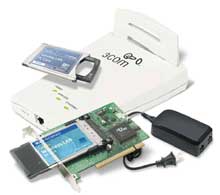

3Com Wireless
3Com: 802.11b & 802.11a Comparison
Total Solutions
click on headline for full story
©2002 Total Technologies, All Rights Reserved Some Stories Courtesy 3Com Corporation


Comparing Performance of 802.11b and 802.11a Wireless Technologies
In order to be successful, any wireless technology must demonstrate performance in the areas of range, throughput, type of service, and coverage. The IEEE 802.11b wireless local area network (WLAN) standard takes an interesting approach to these questions. It implements an adaptive method that uses different modulation techniques to achieve a long range with reduced bit rates and a shorter range with higher bit rates. 802.11b technology has been very successful and its performance is well understood. The next generation WLAN technology, 802.11a, is likely to become available within the next year, sparking questions about its range and performance. There are two major differences between 802.11a and 802.11b:
• The type of modulation. 802.11a uses orthogonal frequency division multiplexing (OFDM) to enable efficient use of available bandwidth.
• The carrier frequency. 802.11a uses the 5.2 GHz band, while 802.11b uses the 2.4 GHz band.
To assess the performance difference between the 802.11b and 802.11a technologies, it is important to understand the propagation performance in these two frequency bands. Because the 802.11acarrier frequency is more than twice as high as the 802.11b carrier frequency, the electromagnetic propagation through the channel should theoretically attenuate the signal twice as much (6 dB according to the Friss equation).
This holds true in an"open field" situation. In an indoor environment, additional parameters must be considered, such as reflection, wall penetration, how fast the channel changes, etc. Because of the complexity of these parameters, is nearly impossible to arrive at a generic formula to accurately describe indoor propagation. Models have been generated to give some insight into this question, such as the Motley-Keenan model [2], long-distance models [3], multi-breakpoint models [4], and sophisticated ray-tracing techniques [5]. Some of these indoor models do suggest that a carrier frequency that is twice as high will indeed attenuate the signal by 6 dB [6], but other models do not [2].
The best way to obtain an understanding of this matter is to measure an environment that represents the application’s "best case" and compare the results for 2.4 GHz and 5.2 GHz propagation. Because WLANs are typically used in an office environment, we performed these measurements in a common U.S. office environment: a building with metal floor and metal roof, cubicle walls with metal sheets inside, and some drywall in the line-of-sight (LOS) path [1]. We found that in the case of a LOS path, where the TX and RX vertical polarized antennas were above the cubicles, the average path loss difference between 2.4 GHz and 5.2 GHz was around 7 dB.
When the antennas had a non-LOS path (e.g., one antenna inside a cubicle), the difference was 2 to 3 dB. This indicates that with more reflection in the path, there is less difference in propagation between different carrier frequencies. These results suggest that with proper antenna positioning, 802.11b will have an additional link budget of about 6 to 7 dB compared to 802.11a. However for less optimal antenna positions, this difference is closer to 2 to 3 dB.
Additional factors play an important role in the actual range difference between802.11b and 802.11a, such as the achievable TX power and RX sensitivity(we use "achievable" rather than "allowable" because for 802.11a it is very difficult to get high TX power with commercially available power amplifiers with linear performance to guarantee proper receiver sensitivity for the high bit rates), use of antenna diversity schemes, use of sophisticated time equalizers for 802.11b, etc. Current 802.11b implementations show a high level of optimization with respect to these parameters.
When we compare 802.11b at 11 Mbps and 802.11a at 6 Mbps, the data throughputs are similar because of the greater efficiency of the 802.11a protocol. The available link budgets are also about the same. In this comparison, therefore, the propagation is the only major difference.
The propagation indicates that in the best case, 802.11b can go roughly 50 to 70 percent farther than 802.11a. In the worst case the range is nearly the same.
Overall it can be concluded that the high rate ranges of 802.11b are very similar to the "low rate" ranges of 802.11a. This finding can help in the creation of a wireless network transition between 802.11b and 802.11a with respect to access point placement. 802.11a access point density should be increased relative to 802.11b in order to take full advantage of the available bandwidth in 802.11a.
[1] Niels van Erven, Robert Yarbrough, Lloyd Sarsoza, "2.4 and 5 GHz propagation measurements for WLAN", 3Com.
[2] J.M. Keenan, A.J. Motley, "Radio Coverage in Buildings," British Telecom Technology Journal, Vol. 8, No.1, January 1990, pp. 19-24.
[3] T. Rappaport, "Wireless Communications," Prentice Hall, New Jersey, 1996.
[4] D. Akerberg, "Properties of a TDMA Picocellular Office Communication System," IEEE Globecom, pp. 1343-1349, December 1988.
[5] K. Pahlavan, A. Levesque, "Wireless Information Networks," J. Wiley & Sons, Inc.,New York, 1995.
[6] Devasirvatham, et al., "Multi-frequency radiowave propagation measurements in theportable environment," IEEE International Conference on Communications, pp. 1334-1340, 1990.